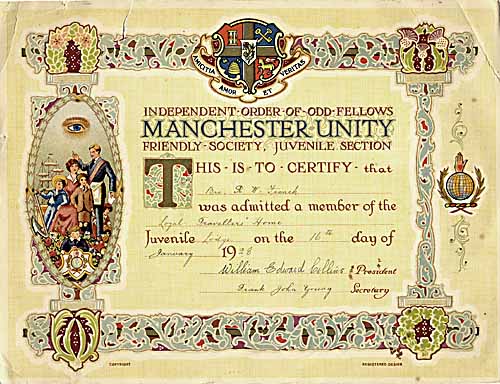|
The Sun, Moon & Stars , Blisworth, Northamptonshire, UK. All pictures are presented at relatively low resolution. Any interest in copies of a picture at a higher resolution (ie. clarity) should be directed through contacts given in the Blisworth "Round and About" parish council publication or using the comment form on the home page. In some cases the pictures are not available due to copyright restrictions. However, permission has been obtained, where possible, to include them here. Printed below each image is the photographer's name, if known. |
|
|
This building is listed - information available The building is also the subject of a compulsory purchase order and both the county council and some villagers are engrossed in the question 'what to do with the old building' - information available |
|
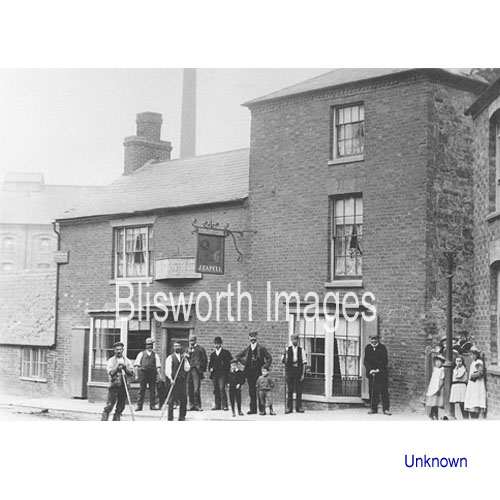 |
31-01 Photographed in c. 1895, John Capell, the publican, stands by the door with light-coloured bowler and dog. The men with pitch forks are part of Capell's threshing team - threshing was carried on as a side line in the yard behind the inn. In earlier years John Capell was the foreman of an ironstone digging gang that operated in Blisworth - probably from 1870-1900. The man, evidently with large moustache and two young boys, is William Ayres. In the late 18th century, the building was extended from an earlier building purchased by John Linnett from Thomas Smith on 19 May 1797. The fact that Smith was a freeholder lends support to the idea that the building was an inn before Linnett's time. He was recorded with license in 1796 onwards. |
|
DETAILS OF THE EARLY HISTORY OF THE SUN, MOON AND STARS.
This is an extract from Taylor's notes made in 1718 in preparation for the Bridges County History. A transcription of he full document which applies to Blisworth is available by clicking here. Taylor is answering a number of set questions as he visits the parishes of Northamptonshire. This is the question about any "hambletts or innshipps" (spelt variously). For Blisworth he has no comment about the former - ie. there are no hamlets (The Arm was formed about 100 years later). He states there is one innship yet we would supposed at least two; The Royal Oak (probably with its former name The Plough Alehouse as mentioned in Grafton records) and The Sun, Moon and Stars recorded as "The Chequers". He states the one as follows: S W clo is the Woodhouse & belongs to Mr. Pickering of Bugbrook. A visit to the Bodleian Library is necessary to elucidate what the copyist has missed with the camera but the archivists at NRO suspect what is being recorded there is "south-west close by" and so it must refer to the Sun, Moon and Stars in an earlier incarnation. The oldest Grafton entry refers to it being called The Chequers Ale House around 1740 and that it was in a very poor state. A working theory for the pubs timeline of Blisworth is therefore as follows: 1718
- just the one, The Woodhouse (the property or just the trade owned by
Mr. Pickering of Bugbrooke). Probably a three storey building
built entirely of stone, having a long ridged
roof parallel to the road, one chimney. A summary of the subsequent History of the Sun, Moon & Stars building, with some repetition of the above, is available on this website. |
|
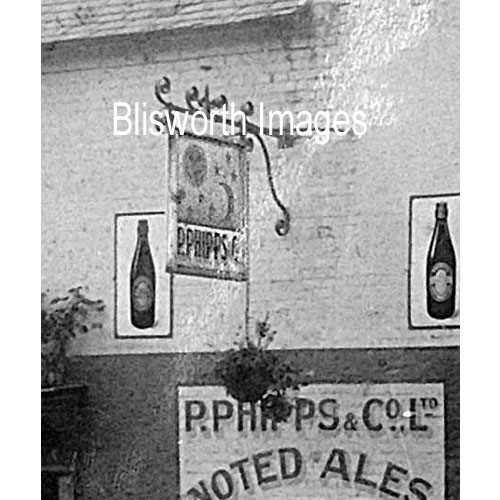 |
Enhanced from a later picture than that above. Note that the sign has been changed - the moon is the other way around. There seem to be only six stars. |
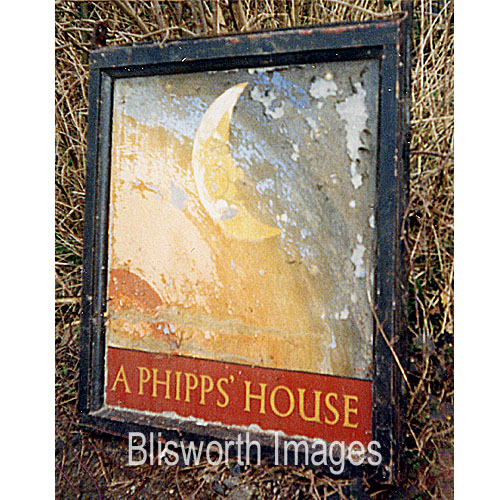 |
In the picture above, the sun, moon and stars logos are quite distinct. Here is another sign but no one in the village seems to remember it. We guessed it dated from around 1960 and a guy from Phipps NBC wrote to the website to explain: "The sign dates to the early and mid 1950s. The Phipps company merged with NBC in 1957 and started re-branding their pubs using the composite name, Phipps NBC and logo from that date. Watney Mann took over in 1960 and from 1964 onwards the name was rationalised back to Phipps Brewery Ltd. Pub signs from this period were branded "A Phipps house" but the distinctive Watney typeface was used. The thin serifed typeface your sign displays was a post war style. Hope this solves a minor mystery" - Mr. Neville, Phipps NBC. |
|
Footnote: There are three cottages to the right of the inn (just visible) and four cottages behind the building. They were built in 1891 and all are still in use. At that time there was built a few (more?) stables somewhere behind the building. None of the stables now survive. The inn was owned at that time by the brewers Phipps. The surrounding land was rented from the Duke of Grafton, hence the appearance in the Grafton Records of Phipps seeking permission to build from the Duke. |
|
|
|
From 1798 the inn was known as the "Half Moon". It was designated a Manchester Odd-fellows Society Travellers Lodge in around 1842. It was No. 2645 - a meeting house where benefits for needy society members would be administered and one of a chain of inns to which a doctor could be called to alleviate ills. A sun, a moon and a ring of seven stars, along with the ubiquitous 'all seeing eye', are all part of the logo of the society displayed on the certificate for the building. This was thought to explains the inn's name change in Victorian times to "Sun, Moon and Stars" - see footnote below. However the symbolism used by the society in their meetings seems likely to have give rise to the name directly. Here is shown one of the personal certificates for junior members an image of which has been kindly supplied by both Peter Sturdgess and Ron French's daughter, Linda Burrows. The certificates of this era are signed by Wm. Collins and Frank Young. Note the full name of the society on the certificate. |
|
Footnote: The
Clerk of the Parish Council refers to this inn as "The Half Moon
Inn" on numerous occasions up to at least 1915. It is
possible that the council worked from an "Award Map" c. 1812
and regarded everything on it as official*. An August 1921 postcard from Blackpool to
Miss Nell Capell is addressed: "Half Moon, Blisworth" while
the sign outside the pub clearly indicates "Sun, Moon and
Stars" in 1895 when her father was the publican (see 31-01
above). Indeed the various directories refer to the public house
as the Sun & Moon or Sun Moon and Stars or Sun Moon and Seven Stars
from the earliest record - that being the Whellan directory in 1849.
Please see the recent
revelation that the names derive directly from symbolism used in
ceremony. |
|
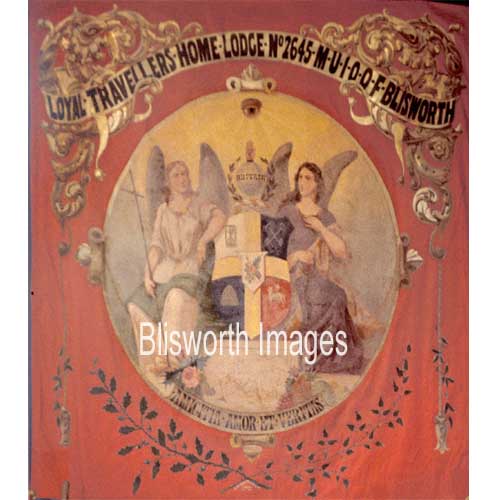 |
31-07 The Odd Fellows banner photographed in the Church at the time of George Freeston's 1981 "Great Exhibition. It had hung in the south aisle for 18 years before that. By 1999 the "fabric had died..." George Freeston and Whitty refer to the banner as hand-painted on silk. Further information on the Order and other "benefits" clubs can be obtained. The link simply takes you further down this page. Origin of the "Oddfellows" is given in an open source article which can be downloaded here. |
|
Footnote: 1849, a few years after the official establishment of the Lodge (and many years after the first hint of what is thought to be a significant name change, 1822) there was started a register of names of those joining the order. Since 2009 this register is kept at the N.R.O. and has been carefully inspected and copied. It reveals a steady flow into the society, largely by the young and often at the youngest age permissible - 18 years. In the early years those joining were mostly from outside Blisworth but by the 1920s this trend had reversed. Joining was seen to begin tailing off by the 1950s. |
|
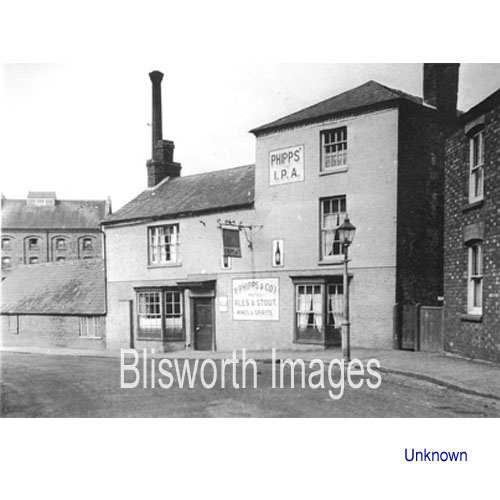 |
31-02 Taken c. 1934. Conversion to gas lighting had taken place and the mill steam chimney had not being taken down by the Canal Company who bought the mill in 1930. For a closer view of the sign (taken from yet another photograph) - please click here.
|
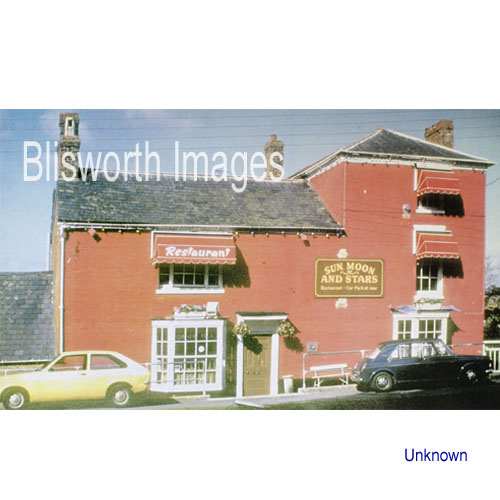 |
31-03 Taken in 1975 when the building
was operated as a licensed restaurant. The picture available
here shows the interior of the building at about the same time -
from a postcard. It would be appreciated if someone could confirm
the appearance as few seem to recall it . . .
The building has decayed considerably since the 1970s. It is the subject of a compulsory order and is listed. |
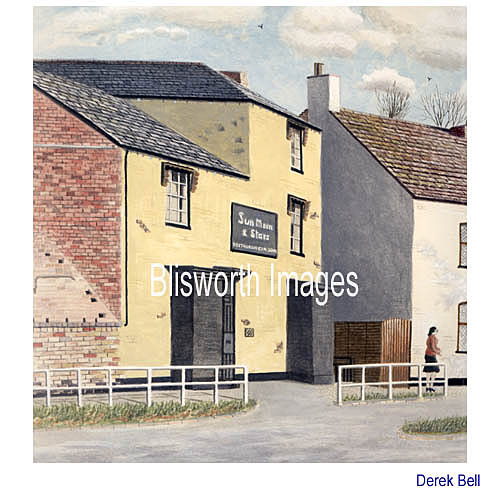 |
From a recently discovered painting by the late Derek Bell of Blisworth who died suddenly in 2002. This was painted in about 1990 while it was shuttered and neglected. Amusingly, Derek has ghosted in the roof pitch of the 20th century kitchen area, to the left, that was demolished one icy morning by a speeding lorry. |
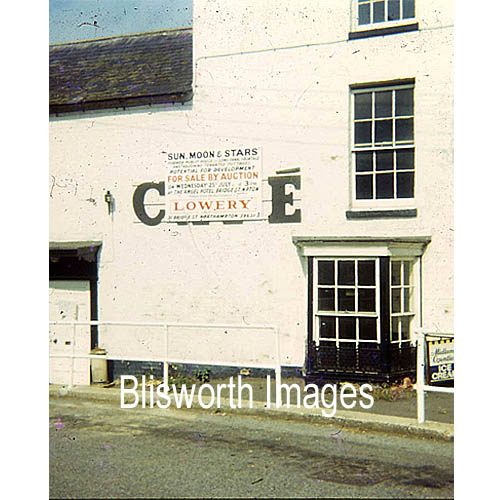 |
Mrs Rivett's cafe closed in 1973. |
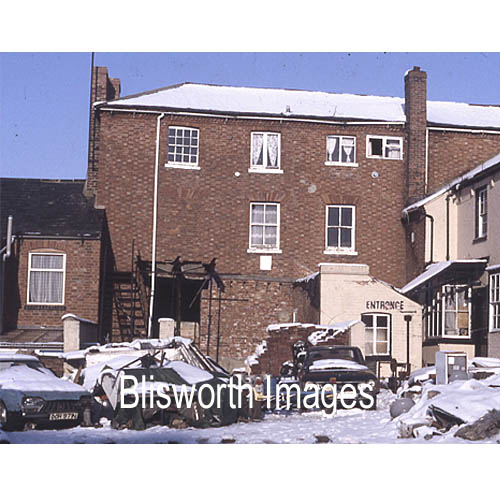 |
The rear of the building in 1986 before any tidying up had been carried out. It is instructive to examine a recent photograph in the history article. |
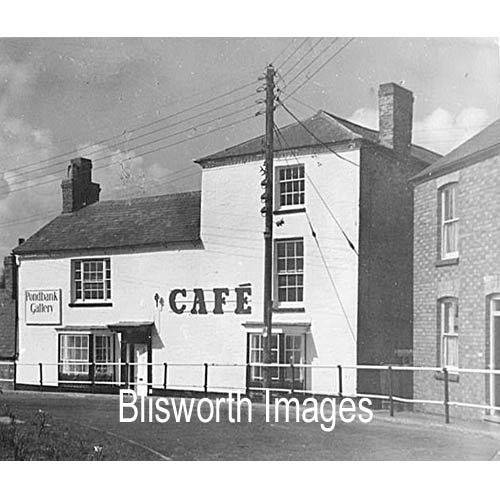 |
Taken in the 1970s when Peter Newcombe and Wendy Freeston were running an Art and Craft gallery in the building. Products sold included pottery, paintings, woodcraft - turned items and walking sticks, screen printed fabrics including tea-towels etc., embroidery and lampshades. The enterprise was called "Pondbank Gallery" and it is said, by someone who would know, that it made very little profit, a point that has been made to those who wish to regenerate a commercial activity in the building. There are a few subsidiary pictures, including one of yards of screen-printed fabric drying in the sun in the garden behind "The Nook", Church Lane.
|
| 31-05 These two pictures show the
rear of the Sun, Moon & Stars cottages from the other side of the
canal. The date is uncertain but there is no sign of the building
of the Pond Bank group of houses which were begun in 1968.
Prior to the building of the cottages, in 1891 by the brewer Phipps, there was evidently a large building contiguous with the road-fronting inn which extending all the way down to the towpath. Such building appears on the award map 1808 and on another map of uncertain origin 1809. Perhaps in such extensive accommodation there was indeed space for many tunnel workers - as the local lore says.
|
|
| 31-06 Someone anonymous corrects us - saying these two pictures are by Walter Alexander. Perhaps there were 3 once (one more between these two), with Walter's idea to create a panorama. | |
|
Further information on the Oddfellow Order and other "benefits" clubs can be found below. |
|
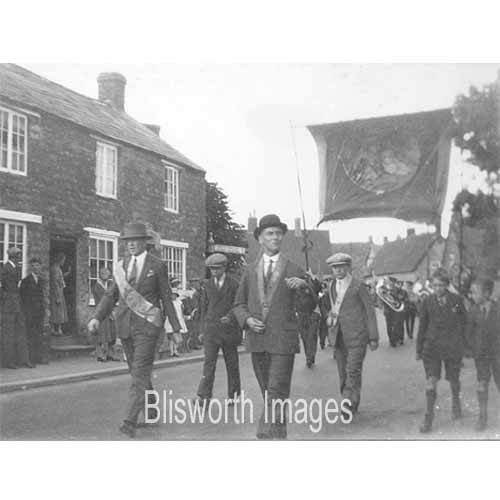 |
31-08 Leading the procession of the Oddfellows Society by the Cross is, on the left William Collins, and right Frank Young (brother of grocer Oliver Young). The lad behind with the sash is Arthur Twisleton, junior officer who rises to be the last of the "Grands" before the society was folded up. Date of this picture c. 1930s. Other procession pictures can be found in the Occasions section.
|
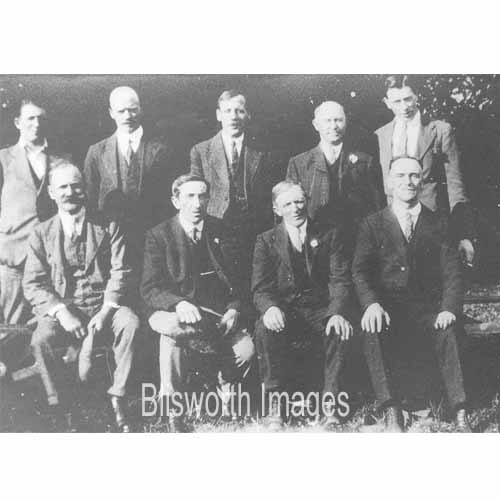 |
31-09 Nine members of the
Oddfellows c. 1946.
Left to right: back: Harry Leach, Arthur Packwood, Sam Newbery, Samuel Lack, Wm Collins. front: Fred Ratledge, Edgar Ayres, Frank Holding and Frank Young. As explained elsewhere, the society was a benefits club but one which set out in Victorian times (c. 1842) with a very strict code expected of members. There was a "Book of Fines" which seems to be lost but notes from it suggest a fine of 6d (about 5% of weekly income) for none attendance to meetings, others for not addressing the meeting when leaving. Meetings were originally held with a strict etiquet for clothing and ritual - akin to a masonic meeting. The chief purpose of the society became to make collections for a fund which may be dispensed as sick pay for workers who had piece-time employment, ie. most workers in the village. With the coming of state pensions, legislation for workers' protection and the National Health Service, the society instead offered an investment and savings fund. |
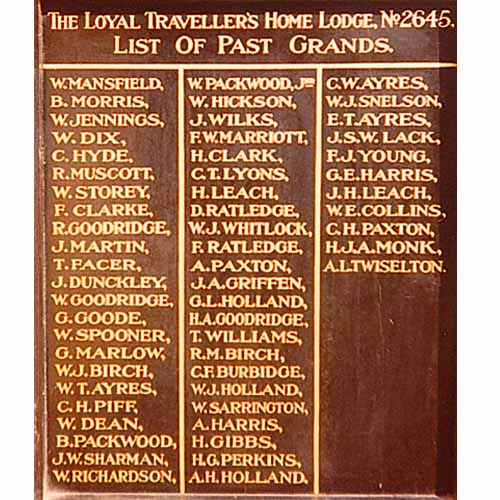 |
31-10 The society began in the rooms at the Sun, Moon and Stars but was moved to a room at the Royal Oak. On a wall there, probably in what became known as "The Club Room" - now the skittles room, was hung this panel with a hinged cover. The panel lists the masters of this branch of the order up to the final year before the Blisworth group was disbanded in 1974 - after over 100 years. It is thought that the order did not have its own Grand master for a few years as W. Mansfield joined in 1841 uninitiated. Actually the landlord at the Royal Oak gave the group notice to quit using the room in 1956 and from then on they met in the Baptists Lecture Hall.
|
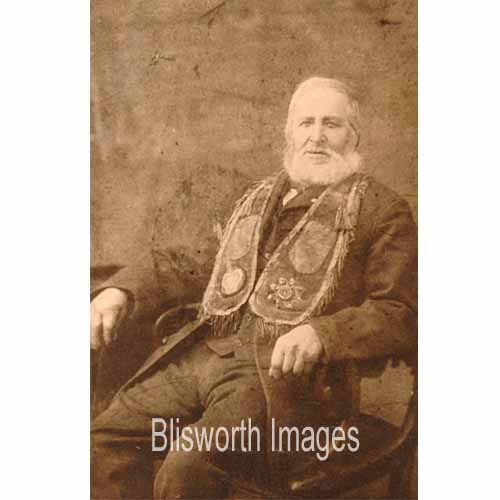 |
31-11 There were at least
two other orders/clubs with a similar aim to that of the Oddfellows.
This is Henry Plowman (died 1916) who was the "master" of the order of
"Good Templars No. 3353" in Blisworth. The order
probably faded out c. 1900 because nothing more could be found out about
it by GF in 1953 other than it too was a strict order but based upon
Baptists members. Baptist records first mention the Templars in
1879. Junior members learnt discipline and debating
skills, meeting in the Baptists Lecture Hall. The club was
strictly teetotal, unlike the Oddfellows, and it bore the full title
of "The Independent Order of Good Templars".
Presumably because people who were only very junior members could be
reached by 1953, the one remaining memory was that there was an acronym
IOGT which youngsters converted to "I O Granny Tuppence".
Contemporaneously with this order was the "Blisworth Benefits Club" which aimed to provide assistance for poor families esp. the unemployed. Image number 23-01 in the occasions section is an early picture of one of their parades. |

